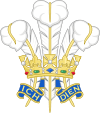Earl of Chester facts for kids
Quick facts for kids Earldom of Chestersubsidiary of Principality of Wales since 1343 |
|
|---|---|

|
|
| Creation date | 1067 (first creation) 1071 (second creation) 1254 (third creation) 1264 (fourth creation) 1301 (fifth creation) 1312 (sixth creation) see Prince of Wales for further creations |
| Monarch | William the Conqueror (first creation) William the Conqueror (second creation) Henry III (third creation) Henry III (fourth creation) Edward I (fifth creation) Edward II (sixth creation) |
| Peerage | Peerage of the United Kingdom |
| First holder | Gerbod the Fleming, 1st Earl of Chester |
| Present holder | William, Prince of Wales |
| Heir apparent | Non-Hereditary |
| Extinction date | 1070 (first creation) 1237 (second creation) 1272 (third creation) 1265 (fourth creation) 1307 (fifth creation) 1327 (sixth creation) |
| Former seat(s) | Chester Castle |
| Motto | Ich dien (I serve) |
The Earldom of Chester was a very important title in medieval England. It covered a large area, mainly in Cheshire and Flintshire. For a long time, the title has been given to the person who is expected to become the next King or Queen of England. Since the late 1300s, it has always been given along with the title of Prince of Wales.
Contents
What was the Earldom of Chester?
The area of Cheshire was controlled by powerful leaders called Earls of Chester. This started in the late 1000s. These earls owned land all over England. They were so powerful that they acted almost like independent rulers in Cheshire. This special power led to the area being called a "County Palatine."
A County Palatine was a special region where the Earl had royal powers. This meant they could rule their land almost like a king. For example, the famous Magna Carta, a document that limited the power of King John, did not apply to Cheshire. The sixth Earl of Chester even had to create his own version of the Magna Carta for his lands!
Chester and the Prince of Wales

In 1237, the last Earl of Chester from the original family died. The Earldom then went back to the King. King Henry III later gave control of Chester to his son, Edward. When Edward became King Edward I, he gave the title and lands of the Earldom to his own son, also named Edward. This son became the first English Prince of Wales.
The Earldom of Chester was very important for King Edward I. It helped him conquer north Wales. The city of Chester was a key base for supplies during the Welsh Wars (1275–1284). Because of its importance, Chester kept its special "County Palatine" status.
Since 1301, the title of Earl of Chester has almost always been given to the Prince of Wales. For example, the King's eldest son automatically becomes the Duke of Cornwall. But he must be specifically given the title of Earl of Chester, usually at the same time he is made Prince of Wales.
The special powers of the County Palatine of Chester lasted until the time of King Henry VIII (around 1536). After that, the Earldom came more directly under the King's control.
Who were the Earls of Chester?
The title of Earl of Chester was created several times throughout history. Here are some of the most notable Earls:
First Creation (1067–1070)
Second Creation (1071)
- 1071–1101 Hugh d'Avranches, 1st Earl of Chester
- 1101–1120 Richard d'Avranches, 2nd Earl of Chester
- 1120–1129 Ranulf le Meschin, 3rd Earl of Chester
- 1129–1153 Ranulf de Gernon, 4th Earl of Chester
- 1153–1181 Hugh de Kevelioc, 5th Earl of Chester
- 1181–1232 Ranulf de Blondeville, 6th Earl of Chester
- 1232–1232 Matilda of Chester, Countess of Chester suo jure (She inherited the title for a short time)
- 1232–1237 John of Scotland, 7th Earl of Chester
Third Creation (1254)
- Edward, Lord of Chester (He later became King Edward I)
Fourth Creation (1264)
- Simon de Montfort, 6th Earl of Leicester, 1st Earl of Chester (He lost the title in 1265)
Fifth Creation (1301)
- Edward of Caernarvon, Earl of Chester (He later became King Edward II)
Sixth Creation (1312)
- Edward Plantagenet, Earl of Chester (He later became King Edward III)
After these creations, the Earldom of Chester was always given together with the title of Prince of Wales. You can find more about the later Earls of Chester by looking at the list of Princes of Wales.
Other Interesting Facts
- A type of steam locomotive built for the Great Western Railway between 1891 and 1915 was named Earl of Chester.
See also
- History of Cheshire
- Constable of Chester
- Countess of Chester (title), a title sometimes held by the Princess of Wales


